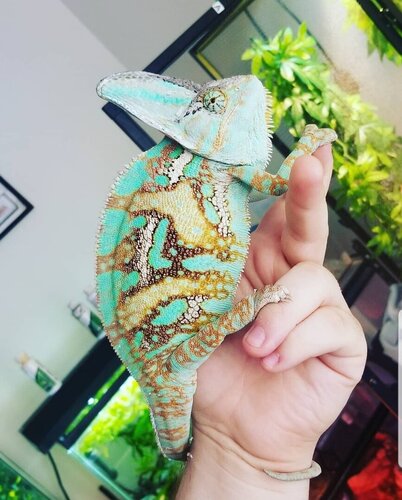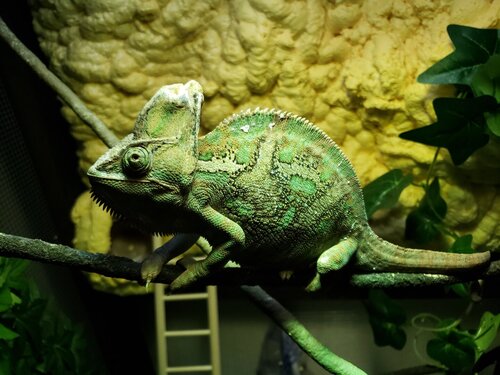Josephmuse
New Member
Your Chameleon - Male Veiled Chameleon, owned since August 2018, not sure of age (Got from a rescue)
Handling - He comes out several times a week, climbs on the blinds and sometimes does educational programs. He really seems to like coming out and will reach up to grab onto me when I go into his enclosure.
Feeding - He eats mealworms, crickets, superworms, and roaches. Food is gut loaded. He eats like a horse, would eat and eat and eat if I let him.
Supplements - Food is supplemented with ZooMed Repticalcium with D3 and Reptivite every feeding.
Watering - Has a waterfall suspended half way up his enclosure that provides constant, flowing water. His enclosure is equipped with a misting system that sprays a few seconds every hour.
Fecal Description - Fecal matter is normal color (Brown and white) and normal consistency.
History - He came to me from a rescue. He did get a thermal burn on his Casque shortly after I got him (Roommates had a chameleon at the time and I followed there advice on enclosure, bad idea...). That was treated by the vet and the burn has since fallen off. He gets a antibacterial ointment on his Casque because the skin is still growing in.
Cage Info:
Cage Type - Lives in a custom built 2'x2'x4' wood and screen enclosure.
Lighting - Has a linear t5 UVB bulb and a deep dome reptiglow heat lamp 125w (I think? Can't find box and can't find the bulbs info on its side. Sorry)
Temperature - Daytime : Basking is 92.8f. Mid cage is 78.1f. Bottom is 73.9f. Nighttime : whole cage goes like 68f to 72f.
Humidity - Not sure what exactly it is. There is not a place to mount a humidity gauge in this screen cage. I am currently running on an, "I feel it is appropriate because he sheds well when he sheds" system. Eventually I will have one mounted on the back when I turn it bioactive.
Plants - Not yet, have some propagating in bins, waiting for me to finish the back of the enclosure.
Placement - In my living room, surrounded by the other reptiles and amphibians we own.
Location - The Pacific Northwest
Current Problem - My chameleon is always dark. He used to be really vibrant and colorful. Then the burn happened and I, and the Vet, figured he was dark because he was not really eating and was undergoing treatment. He is now long into recovery from that incident and has regained his enormous appetite. He sheds well, is very active, and loves coming out. Anyone else have this problem? I will attach photos of how he used to look versus how he looks now.
Thank you for any information you may have.
Handling - He comes out several times a week, climbs on the blinds and sometimes does educational programs. He really seems to like coming out and will reach up to grab onto me when I go into his enclosure.
Feeding - He eats mealworms, crickets, superworms, and roaches. Food is gut loaded. He eats like a horse, would eat and eat and eat if I let him.
Supplements - Food is supplemented with ZooMed Repticalcium with D3 and Reptivite every feeding.
Watering - Has a waterfall suspended half way up his enclosure that provides constant, flowing water. His enclosure is equipped with a misting system that sprays a few seconds every hour.
Fecal Description - Fecal matter is normal color (Brown and white) and normal consistency.
History - He came to me from a rescue. He did get a thermal burn on his Casque shortly after I got him (Roommates had a chameleon at the time and I followed there advice on enclosure, bad idea...). That was treated by the vet and the burn has since fallen off. He gets a antibacterial ointment on his Casque because the skin is still growing in.
Cage Info:
Cage Type - Lives in a custom built 2'x2'x4' wood and screen enclosure.
Lighting - Has a linear t5 UVB bulb and a deep dome reptiglow heat lamp 125w (I think? Can't find box and can't find the bulbs info on its side. Sorry)
Temperature - Daytime : Basking is 92.8f. Mid cage is 78.1f. Bottom is 73.9f. Nighttime : whole cage goes like 68f to 72f.
Humidity - Not sure what exactly it is. There is not a place to mount a humidity gauge in this screen cage. I am currently running on an, "I feel it is appropriate because he sheds well when he sheds" system. Eventually I will have one mounted on the back when I turn it bioactive.
Plants - Not yet, have some propagating in bins, waiting for me to finish the back of the enclosure.
Placement - In my living room, surrounded by the other reptiles and amphibians we own.
Location - The Pacific Northwest
Current Problem - My chameleon is always dark. He used to be really vibrant and colorful. Then the burn happened and I, and the Vet, figured he was dark because he was not really eating and was undergoing treatment. He is now long into recovery from that incident and has regained his enormous appetite. He sheds well, is very active, and loves coming out. Anyone else have this problem? I will attach photos of how he used to look versus how he looks now.
Thank you for any information you may have.



